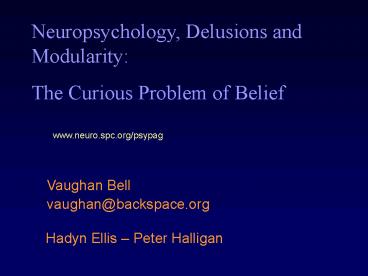Neuropsychology, Delusions and Modularity: - PowerPoint PPT Presentation
1 / 14
Title:
Neuropsychology, Delusions and Modularity:
Description:
Cognitive Neuropsychology and Current Conceptual Tools. ... Elvis lives' vs Elvis is buried at Graceland' We aim for maximum coherence in our belief set. ... – PowerPoint PPT presentation
Number of Views:61
Avg rating:3.0/5.0
Title: Neuropsychology, Delusions and Modularity:
1
Neuropsychology, Delusions and Modularity The
Curious Problem of Belief
www.neuro.spc.org/psypag
Vaughan Bell vaughan_at_backspace.org
Hadyn Ellis Peter Halligan
2
Outline
- Delusions and Belief.
- Cognitive Neuropsychology and Current Conceptual
Tools. - Problems with modular approaches to belief.
- Approaches for crossing the divide.
3
Notable Delusions
- Shot by John Hinckley, who believed that this
would cause Jodie Foster fall in love with him.
4
Notable Delusions
Philip K Dicks writing often drew on delusional
experiences.
5
Clinical Definition
- Delusions, as defined by psychiatrists are
- fixed false beliefs based on an incorrect
inference about external reality that is firmly
sustained despite what almost everyone else
believes and despite what constitutes
incontrovertible and obvious proof or evidence to
the contrary - (DSM-IV-TR)
6
Delusion / Belief Relationship
- Despite the fact that almost every one of these
points can be argued with (Spitzer, 1990 David,
1999) - Delusions are, by and large, considered as
beliefs (albeit pathological ones). - Therefore an attempt to understand the
neuropsychology of delusions, needs to be able to
tackle the neuropsychology of belief. - As is the explicit objective of Cognitive
Neuropsychiatry in this area.
7
Traditional CN Approach
- Traditionally, cognitive neuropsychology has
relied on several assumptions to allow the study
of pathology to uncover normal functioning. - Modularity is one such assumption.
- It assumes that fundamental cognitive process are
independent and encapsulated within the brain. - With these assumptions we can uncover previously
unknown modules by studying differences in
behaviour after pathology.
8
The Belief Stumbling Block
- Fodor (1983) the originator of the modularity
hypothesis says that belief is a central
process. - That is, is does not exist as a modular entity
within the brain. - Indeed the relation of brain function to belief
is still particularly controversial. - For example, Churchland (1999) argues that
belief is an outdated concept. - And we will not be successful in determining its
relation to brain function.
9
The Belief Stumbling Block
- This would suggest methods that rely on
modularity assumptions will less useful in
understanding belief. - e.g. The lesion method.
- Which seems to suggest a bleak future for
Cognitive Neuropsychiatry in this area - and its researchers who wish to study delusions
as a way of understanding normal belief
processes.
10
Possible Solutions
- Luckily, a similar problem has been encountered
before. - Burgess (1997) has argued that the executive
system is also a central process. - And has identified particular techniques for a
successful cognitive neuropsychological approach - ..which could be used in cognitive
neuropsychiatry to understand the significance of
delusions.
11
Heterogeneous Samples
- Heterogeneous patient samples can be used.
- Rather than grouping similar patients, by either
syndrome (e.g. schizophrenia) or by delusion type
(e.g. persecutory) - we can select a symptom (delusion) and aim to
include multiple aetiologies in the group. - Common behavioural effects can then be extracted
post-hoc - ..and related to the common psychopathology (in
this case pathologies of belief).
12
Holistic Belief Models
- Many theories talk about the web of belief but
at the moment this is still a black box. - Coherence Theory (Thagard, 2000) gives one
possible way of modelling this. - Element (beliefs) have constraints between them
to either encourage connected beliefs to be
accepted or rejected. - Elvis lives vs Elvis is buried at Graceland
- We aim for maximum coherence in our belief set.
13
Coherence Theory Approach
- Computing maximum coherence is a computationally
intractable problem. - But Hopfield style interconnected neural nets are
very good at creating best fit solutions. - This allows for dynamic and holistic modelling of
belief states. - As well as the ability to test theories of
pathology on the network, leading to testable
predictions.
14
Conclusion
- Cognitive neuropsychiatry as applied to belief
presents some unique challenges. - The neuropsychological approaches derived from
theories of modularity may not be as useful. - Work from similar challenges in executive system
research may be fruitful. - Novel approaches (such as coherence theory) may
be needed to understand wider issues in the
neuropsychology of belief and pathologies of
belief.































